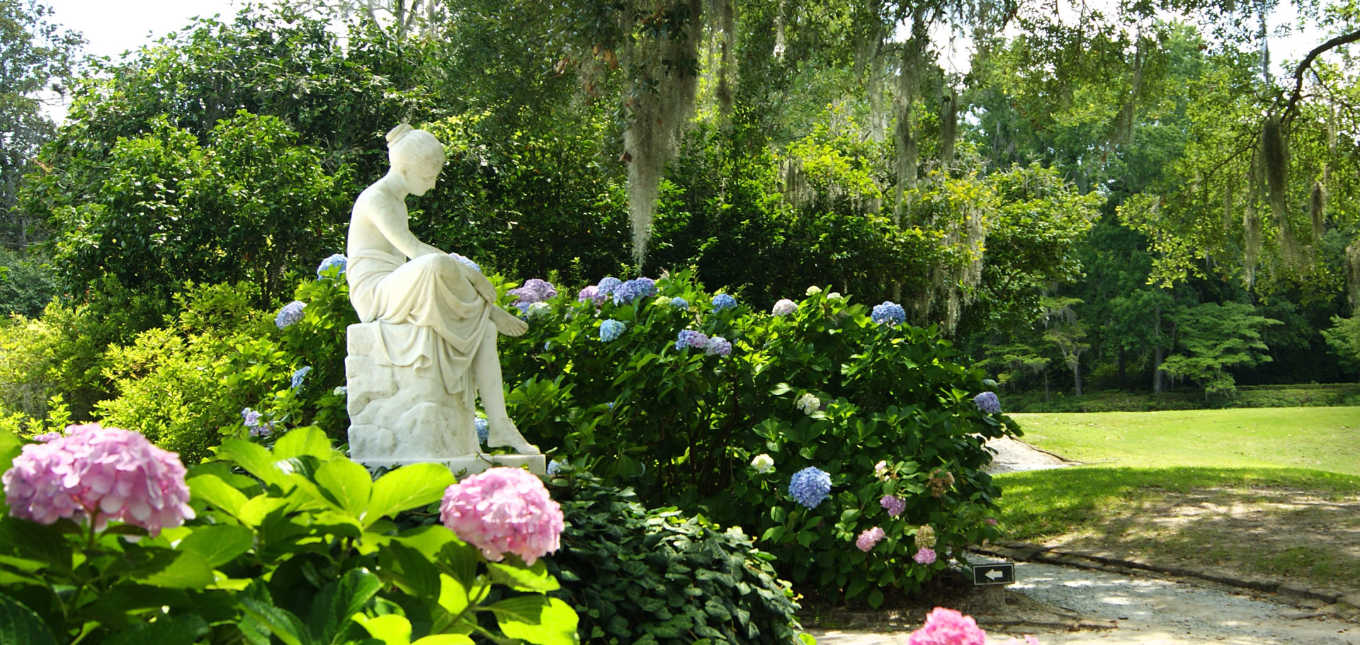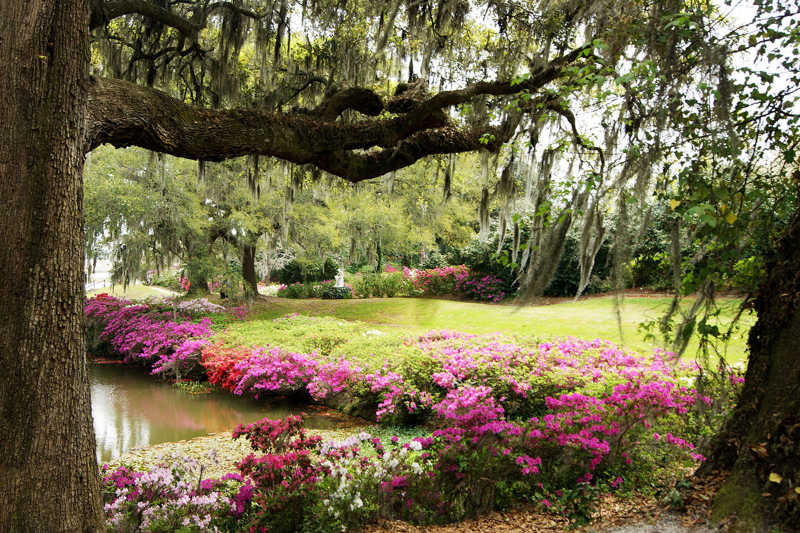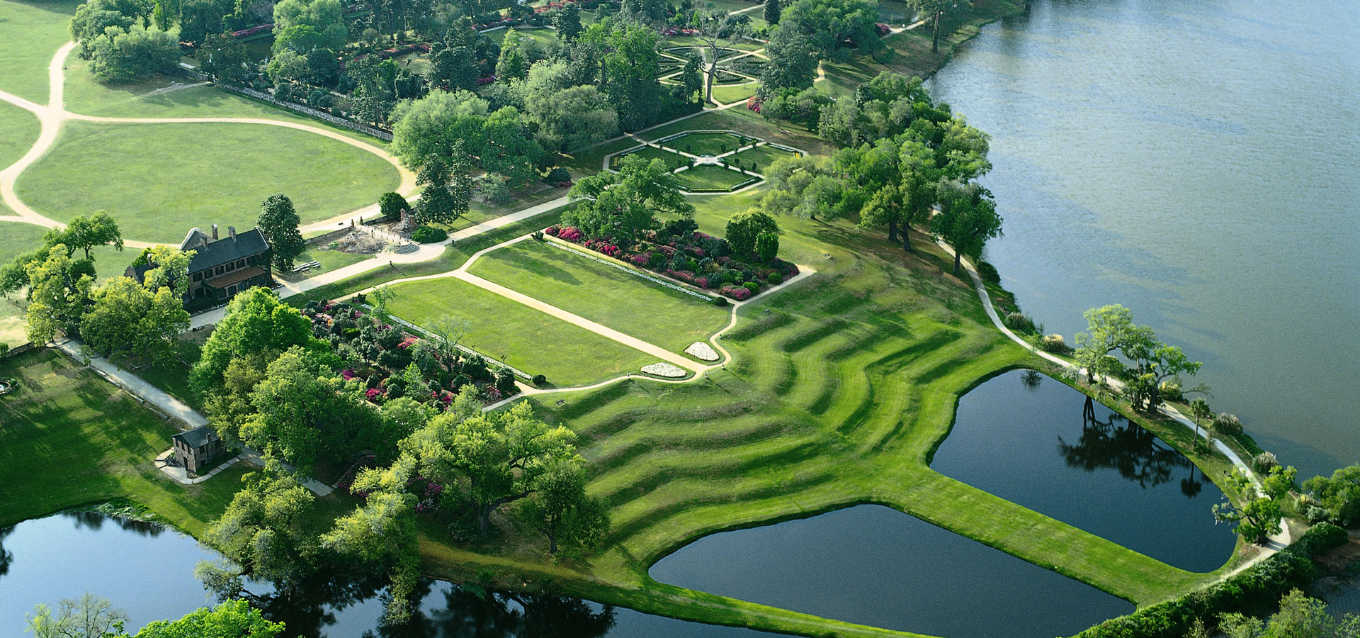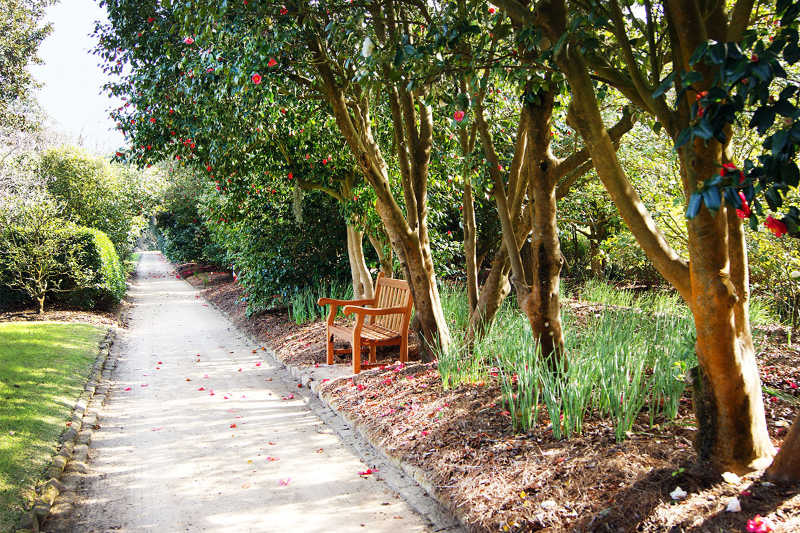Sidney Frazier “King of Camellias” Featured in Charleston Magazine
Our very own Sidney Frazier was recently interviewed by Anna Miller for the Charleston Magazine. We are incredibly grateful for...
Read More
The Gardens, which Henry Middleton envisioned and began to create in 1741, reflect the grand classic style that remained in vogue in Europe and England into the early part of the 18th century. The principles of André Le Nôtre, the master of classical garden design who laid out the gardens at Vaux-le-Vicomte and the Palace of Versailles were followed. Rational order, geometry and balance; vistas, focal points and surprises were all part of the garden design.
Henry Middleton's original gardens contained walkways or allées, which were planted with trees and shrubs, trimmed to appear as green walls that partitioned off small galleries, green arbors and bowling greens. Sculpture was placed at the end of long vistas and ornamental canals designed with mathematical precision. Changes in elevation and new surprises were created at every turn.


The Gardens evolved as subsequent generations made contributions over time. Arthur Middleton, a signer of the Declaration of Independence, befriended French botanist, André Michaux, who is thought to have brought the first camellias in America to Middleton Place. Governor Henry Middleton, Arthur’s son, planted many more camellias and introduced additional plant material, including tea olives and crepe myrtles. Williams Middleton expanded the Gardens, incorporating romantic garden influences, and brought azaleas to the plantation – now over 100,000 in number. In the early 20th century, Heningham Lyons Ellett Smith, wife of Middleton descendant J.J. Pringle Smith, restored the landscape that had been largely neglected for nearly six decades following the Civil War. Her efforts led the Garden Club of America to describe Middleton Place in 1940 as the “most important and interesting garden in America.” It remains so to this day.

Annuals - throughout the gardens
Common Camellia
Throughout the gardens
Winter Daphne
Cypress Lake
Annuals - throughout the gardens
Common Camellia
throughout the gardens
Winter Daphne
Cypress Lake
Tazetta Daffodil
throughout the gardens
Tazetta Daffodil
throughout the gardens
Large-Cupped Daffodil
throughout the gardens
Tazetta Daffodil
throughout the gardens
Spring snowflake
Cypress Lake
Star Magnolia
Inner Garden
Saucer Magnolia
North Paterre
Annuals - throughout the gardens
Common Camellia
Inner Garden
Throughout the Gardens
Azalea
Throughout the Gardens
Dogwood
Throughout the Gardens
Alabama Azalea
North Green Walk, Cypress Lake, Flooded Rice Field Bank
Sweet Azalea
South Green Walk, Cypress Lake, Flooded Rice Field Bank
Florida Flame Azalea
South Green Walk, Cypress Lake, Flooded Rice Field Bank
Mountain Azalea
North Green Walk, Cypress Lake, Flooded Rice Field Bank
Lady Banks Rose
Stableyards, Restaurant East Garden
Golden Club
Cypress Lake
Winter Daphne
Cypress Lake
Trumpet Daffodil
Throughout the Gardens
Tazetta Daffodil
Throughout the Gardens
Tazetta Daffodil
Throughout the Gardens
Large-Cupped Daffodil
Throughout the Gardens
Spring Snowflake
Cypress Lake
Eastern Redbud
Throughout the Gardens
Red Maple
Throughout the Gardens
Chinese Wisteria
Throughout the Gardens
Japanese Wisteria
Half Moon Bridge
Water Hawthorne
Cypress Lake
Viburnum
Throughout the Gardens
Spirea
Throughout the Gardens
Atamasco Lily
Cypress Lake
Tea Olive
Throughout the Gardens
Annuals - throughout the gardens
Confederate Jasmine
Restaurant East Garden
Wild Olive
Camellia Allées
Tea Olive
Throughout the Gardens
Eastern Snowball
Camellia Allées
Slender Deutzia
North Green Walk, Camellia Allées
Pink Minor
Inner Garden
Virginia Sweetspire
Cyprus Lake
Tulip Tree
Throughout the Gardens
Azalea
Throughout the Gardens
Alabama Azalea
North Green Walk, Cypress Lake, Flooded Rice Field Bank
Sweet Azalea
South Green Walk, Cypress Lake, Flooded Rice Field Bank
Florida Flame Azalea
South Green Walk, Cypress Lake, Flooded Rice Field Bank
Mountain Azalea
North Green Walk, Cypress Lake, Flooded Rice Field Bank
Dogwood
Throughout the Gardens
Dogwood
Azalea Lake North Path
Viburnum
Throughout the Gardens
Black Locust
Middleton Tomb
Cucumber Magnolia
South Green Walk
Umbrella Magnolia
South Green Walk
Lily Magnolia
South Green Walk
Bigleaf Magnolia
Azalea Hillside
Viburnum
Throughout the Gardens
Spirea
Throughout the Gardens
India Hawthorn
Inner Garden
Fringe Tree
Throughout the Gardens
Lady Banks Rose
Stableyards, Restaurant East Garden
Atamasco Lily
Cypress Lake
Eastern Red Columbine
Cypress Lake
Golden Club
Cypress Lake
Water Hawthorne
Cypress Lake
Sweet Pepperbush
Cypress Lake
Cherokee Rose
Azalea Hillside at Upper Pond
Yaupon Holly
North Green Walk
Yaupon Holly
North Green Walk
Mountain Laurel\
Throughout the Gardens
Crinum Lily
Azalea Hillside
Amarcrinum
Azalea Hillside
Annuals - throughout the gardens
Sweetbay Magnolia
Inner Gardens
Golden Club
Cypress Lake
Water Hawthorne
Cypress Lake
Southern Magnolia
Throughout the Gardens
Mountain Laurel
Throughout the Gardens
Oakleaf Hydrangea
Azalea Lake
Bigleaf Hydrangea
Wood Nymph Sculpture, Inner Garden,
Penny Mac Hydrangea
Camellia Allees
Florida Hobblebush
South Green Walk, Southwest Corner of Inner Garden
Banana Shrub
South Green Walk
Carolina Allspice
South Green Walk, Flooded Rice Field Bank
Korean Beauty Berry
Cypress Lake South Path
Swamp Rose
Cypress Lake, East and South Path
Golden Canna
Restaurant South
Annuals - throughout the gardens
Penny Mac Hydrangea
Camellia Allees
Water Hawthorne
Cypress Lake
Southern Magnolia
Throughout the Gardens
Sweetbay Magnolia
Inner Gardens
Golden Club
Cypress Lake
American Holly
Secret Gardens & Inner Gardens
Oakleaf Hydrangea
Azalea Lake
Bigleaf Hydrangea
Inner Gardens, Wood Nymph Sculpture
Florida Hobblebush
South Green Walk, Southwest Corner of Inner Garden
Banana Shrub
South Green Walk
Carolina Allspice
South Green Walk, Flooded Rice Field Bank
Korean Beauty Berry
Cypress Lake South Path
Swamp Rose
Cypress Lake, East & South Path
Golden Canna
Restaurant South
Scarlet Rosemallow
Restaurant South
Annuals - throughout the gardens
Ginger Lily
Reflection Pool Walk & Cypress Lake
Ginger Lily
Restaurant Lower Brick Wall
Hardy Canna
Half Moon Bridge
Chaste Tree
Inner Garden
Hortensia
Wood Nymph
Sister Theresa
Inner Garden
Purple Anise
South Magnolia Walk
Yellow Anise
North and South Green Walk
White Florida Anise
Middleton Tomb and Cypress Lake
Abelia
Throughout the Gardens
Glossy Abelia
Throughout the Gardens
American Crinum Lily
Azalea Lake and Mill
Water Hawthorne
Cypress Lake
Golden Club
Cypress Lake
Crape Myrtle
Throughout the Gardens
Glossy-Leaved Paper Plant
Restaurant East
Annuals - throughout the gardens
Glossy-Leaved Paper Plant
Restaurant East
Crape Myrtle
Throughout the Gardens
American Crinum Lily
Azalea Lake and Mill
Hortensia
Wood Nymph
Sister Theresa
Inner Garden
Annuals - throughout the garden
American Crinum Lily
Azalea Lake and Mill
Glossy-Leaved Paper Plant
Restaurant East
Abelia
Throughout the Gardens
Glossy Abelia
Throughout the Gardens
Hortensia
Wood Nymph
Sister Theresa
Inner Garden
Red Spider Lily
Cypress Lake
Annuals - throughout the gardens
Glossy-Leaved Paper Plant
Restaurant East
Tea Plant
North Green Walk
Hortensia
Wood Nymph
Sister Theresa
Inner Garden
Pampas Grass
Butterfly Lakes and Demonstration Rice Field
Annuals - throughout the gardens
Hydrangea Hortensia
Wood Nymph
Hydrangea Sister Theresa
Inner Garden
Pampas Grass
Butterfly Lakes
Tea Plant
North Green Walk
Mine-No-Yuki
Inner Garden
Common Camellia
throughout the gardens
Annuals - throughout the gardens
Mine-No-Yuki
Inner Garden
Common Camellia
throughout the gardens
Our very own Sidney Frazier was recently interviewed by Anna Miller for the Charleston Magazine. We are incredibly grateful for...
Read More